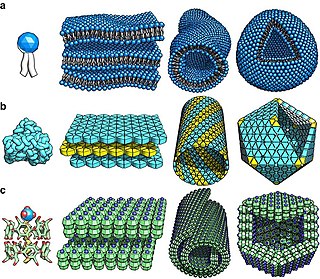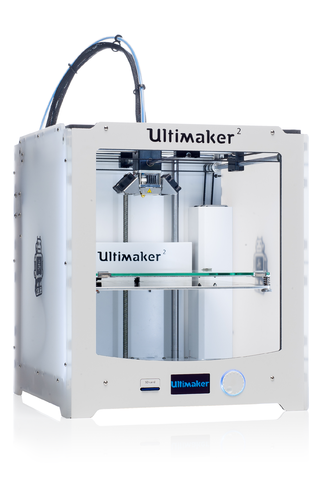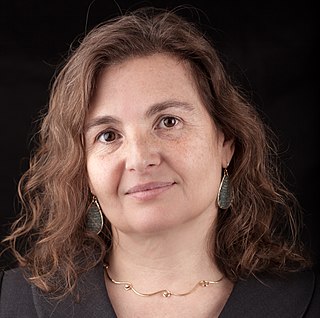
Biomimetics or biomimicry is the emulation of the models, systems, and elements of nature for the purpose of solving complex human problems. The terms "biomimetics" and "biomimicry" are derived from Ancient Greek: βίος (bios), life, and μίμησις (mīmēsis), imitation, from μιμεῖσθαι (mīmeisthai), to imitate, from μῖμος (mimos), actor. A closely related field is bionics.

Self-assembly is a process in which a disordered system of pre-existing components forms an organized structure or pattern as a consequence of specific, local interactions among the components themselves, without external direction. When the constitutive components are molecules, the process is termed molecular self-assembly.

Swarm robotics is an approach to the coordination of multiple robots as a system which consist of large numbers of mostly simple physical robots. ″In a robot swarm, the collective behavior of the robots results from local interactions between the robots and between the robots and the environment in which they act.″ It is supposed that a desired collective behavior emerges from the interactions between the robots and interactions of robots with the environment. This approach emerged on the field of artificial swarm intelligence, as well as the biological studies of insects, ants and other fields in nature, where swarm behaviour occurs.
Supramolecular chemistry refers to the branch of chemistry concerning chemical systems composed of a discrete number of molecules. The strength of the forces responsible for spatial organization of the system range from weak intermolecular forces, electrostatic charge, or hydrogen bonding to strong covalent bonding, provided that the electronic coupling strength remains small relative to the energy parameters of the component. While traditional chemistry concentrates on the covalent bond, supramolecular chemistry examines the weaker and reversible non-covalent interactions between molecules. These forces include hydrogen bonding, metal coordination, hydrophobic forces, van der Waals forces, pi–pi interactions and electrostatic effects.

3D printing or additive manufacturing is the construction of a three-dimensional object from a CAD model or a digital 3D model. It can be done in a variety of processes in which material is deposited, joined or solidified under computer control, with material being added together, typically layer by layer.

Daniela L. Rus is a roboticist and computer scientist, Director of the MIT Computer Science and Artificial Intelligence Laboratory (CSAIL), and the Andrew and Erna Viterbi Professor in the Department of Electrical Engineering and Computer Science (EECS) at the Massachusetts Institute of Technology.

Mitchell Joachim is an architect and urban designer. He is the Co-Founder of Terreform ONE, and an Associate Professor of Practice at NYU. Previously he was the Frank Gehry Chair at University of Toronto and a faculty member at Pratt, Columbia, Syracuse, Washington, The New School, and the European Graduate School.

Neri Oxman is an American–Israeli designer and professor at the MIT Media Lab, where she led the Mediated Matter research group. She is known for art and architecture that combine design, biology, computing, and materials engineering.
Ayyappanpillai Ajayagosh is an organic chemist, academic and the former director of the National Institute for Interdisciplinary Science and Technology. He is known for his studies on supramolecular assemblies and light induced sensor systems and is an elected fellow of all the three major Indian science academies viz. the National Academy of Sciences, India, Indian National Science Academy and the Indian Academy of Sciences as well as The World Academy of Sciences. The Council of Scientific and Industrial Research, the apex agency of the Government of India for scientific research, awarded him the Shanti Swarup Bhatnagar Prize for Science and Technology, one of the highest Indian science awards for his contributions to Chemical Sciences in 2007. He received the TWAS Prize of The World Academy of Sciences in 2013.
Construction 3D Printing (c3Dp) or 3D construction Printing (3DCP) refers to various technologies that use 3D printing as a core method to fabricate buildings or construction components. Alternative terms for this process include "additive construction." "3D Concrete" refers to concrete extrusion technologies whereas Autonomous Robotic Construction System (ARCS), large-scale additive manufacturing (LSAM), or freeform construction (FC) refer to other sub-groups.

Raffaello D’Andrea a Canadian-Italian-Swiss engineer, artist, and entrepreneur. He is professor of dynamic systems and control at ETH Zurich. He is a co-founder of Kiva Systems, and the founder of Verity. He was the faculty advisor and system architect of the Cornell Robot Soccer Team, four time world champions at the annual RoboCup competition. He is a new media artist, whose work includes The Table, the Robotic Chair, and Flight Assembled Architecture.

Marcelo Coelho is a Brazilian computation artist and designer. His work focuses on the boundaries between matter and computation, and includes interactive installations, photography, wearables, and robotics. Coelho is currently a Research Affiliate at the MIT Media Lab and creative director at Marcelo Coelho Studio, an anti-disciplinary studio dedicated to technically innovative and experimental work based in Boston, MA.
Self-assembly based manufacturing refers to a controlled process of using self-assembly and programmable matter to manufacture a product on an industrial scale. In traditional manufacturing and fabrication, there are physical and precision limitations on a workpiece; namely, lower minimal dimension of a workpiece has been a major challenge in modern manufacturing. Engineering self-assembly methods have a significant potentials in overcoming the dimensional limitation of a workpiece. In general, there are three key ingredients in most of self assembly applications: geometry (order), interaction, energy. To improve the efficiency or take shape in self-assembly based manufacturing, it must utilize one or more than one of these three ingredients. This is an emerging market with few examples to date. However, this field shows a strong potential to revolutionize many industrial markets from nanoelectronics to bio-engineering.

Smart manufacturing is a broad category of manufacturing that employs computer-integrated manufacturing, high levels of adaptability and rapid design changes, digital information technology, and more flexible technical workforce training. Other goals sometimes include fast changes in production levels based on demand, optimization of the supply chain, efficient production and recyclability. In this concept, as smart factory has interoperable systems, multi-scale dynamic modelling and simulation, intelligent automation, strong cyber security, and networked sensors.
Dhairya Dand is an Indian-born, American inventor and artist based in New York City.
4-dimensional printing uses the same techniques of 3D printing through computer-programmed deposition of material in successive layers to create a three-dimensional object. However, in 4D printing, the resulting 3D shape is able to morph into different forms in response to environmental stimulus, with the 4th dimension being the time-dependent shape change after the printing. It is therefore a type of programmable matter, wherein after the fabrication process, the printed product reacts with parameters within the environment and changes its form accordingly.

In recent years, 3D printing has developed significantly and can now perform crucial roles in many applications, with the most common applications being manufacturing, medicine, architecture, custom art and design, and can vary from fully functional to purely aesthetic applications.
Jenny E. Sabin is an American architect, designer and artist who draws upon biology and mathematics to design material structures. Sabin is the Arthur L. and Isabel B. Wiesenberger Professor of Architecture in the Department of Architecture at Cornell University. She focuses on design and emerging technologies, with particular emphasis on the areas of computational design, data visualization and digital fabrication.
Shuguang Zhang is an American biochemist. He is at the MIT Media Lab's Laboratory for Molecular Architecture. Shuguang Zhang's research focuses on designs of biological molecules, particularly proteins and peptides. He has published over 170 scientific papers, which have cumulatively been cited over 35,000 times with an h-index of 88. On the “Updated science-wide author databases of standardizes citation indicators”, he is ranked 18th worldwide in the field of Biomedical Engineering. Zhang is also a co-founder and board member of Molecular Frontiers Foundation, which organizes annual Molecular Frontiers Symposia in Sweden and around the world. The selected winners are awarded Molecular Frontiers Inquiry Prize.
Javier G. Fernandez is a Spanish physicist and bioengineer. He is associate professor at the Singapore University of Technology and Design. He is known for his work in biomimetic materials and sustainable biomanufacturing, particularly for pioneering chitin's use for general and sustainable manufacturing.










